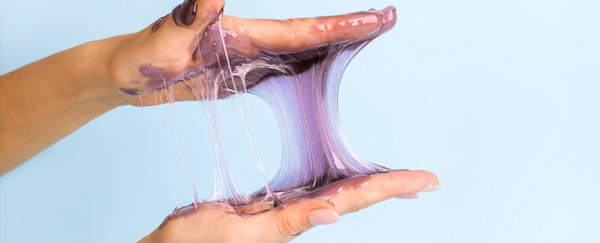The day has finally come. Scientists have finally created synthetic mucus molecules that exhibit the structure and function of the real deal.
Far from being a slime crime, though, it's a discovery that could help scientists devise new treatments for infectious diseases, according to the research team behind the breakthrough.
Slippery, slimy, and oozy, mucus does seem pretty gross. However, as disagreeable as we may find it, the stuff is biologically useful: It acts as a barrier protecting and moisturizing delicate tissues, trapping microbes (for which it's also loaded with antimicrobial enzymes), and contaminants, and helping the body expel them.
Our bodies produce between 1.5 and 2 liters (1.5 to 2 quarts) of mucus every day in the respiratory tract alone; it coats our airways, lungs, and gastrointestinal tracts - we're practically walking bags of miracle goo.
If we could replicate its properties, that could provide us an important tool in the fight against diseases, and this new research is an important step. Scientists led by chemist Austin Kruger of MIT have synthesized mucins, the protein building blocks of mucus.
Mucins consist of a long protein spine bristling with strands of carbohydrate polymers called glycans (much like a fuzzy pipe cleaner); it's unclear how the polymers contribute to the various properties of mucus. Previous research found that they hinder bacteria's ability to communicate with each other, attach to surfaces, and secrete toxins.
The team's synthetic mucins, built around a polymer spine, could help figure it out - not only are they structured just like the real thing, they even replicate some of its functions.
"We would really like to understand what features of mucins are important for their activities, and mimic those features so that you could block virulence pathways in microbes," said chemist Laura Kiessling of MIT.
The difficulty is that mucins are complicated. The protein spine consists of thousands of different amino acids, the scientists said, and there are many different types of glycans that can make up the bristles.
The team started with carbon ring molecules, and used a process that opened them out into a straight line. The resulting molecules, each containing a carbon-carbon double bond, were then joined together to form the polymer spine of the synthetic mucin.
Each carbon atom in the bond is usually bonded to another chemical group, and the polymer can take different forms depending on where they are attached. In the cis form, the two groups - the carbon and the other one, whatever it may be - are on the same side; in the trans form, they are on opposite sides.
The team created both forms in their attempt to synthesize mucins and put them to the test.
The trans polymers turned into weird little blobs that didn't look a lot like mucins. Nor were they particularly effective at capturing the toxins secreted by the Vibrio cholerae bacterium.
The cis polymers, however, remained elongated; and, when exposed to V. cholerae, not only did they capture the toxins effectively, they performed even better than real mucins.
There's still more to be done - the team's work didn't include the glycan bristles - but already it shows great promise. The team neatly demonstrated that the elongated shape of the spine plays an important role in the way mucins functions.
In addition, the team found that the cis polymers were water soluble - more so than natural mucin - which means they have potential for inclusion in topical creams and gels, and maybe even eyedrops.
"Our findings," they wrote in their paper, "outline a critical design principle for synthetic mucin mimics that will guide future studies of mucin's role in microbial symbiosis and pathogenesis and serve as a blueprint for generating mucin mimics that act as lubricants or control microbiome composition and infectious disease."
The research has been published in ACS Central Science.
